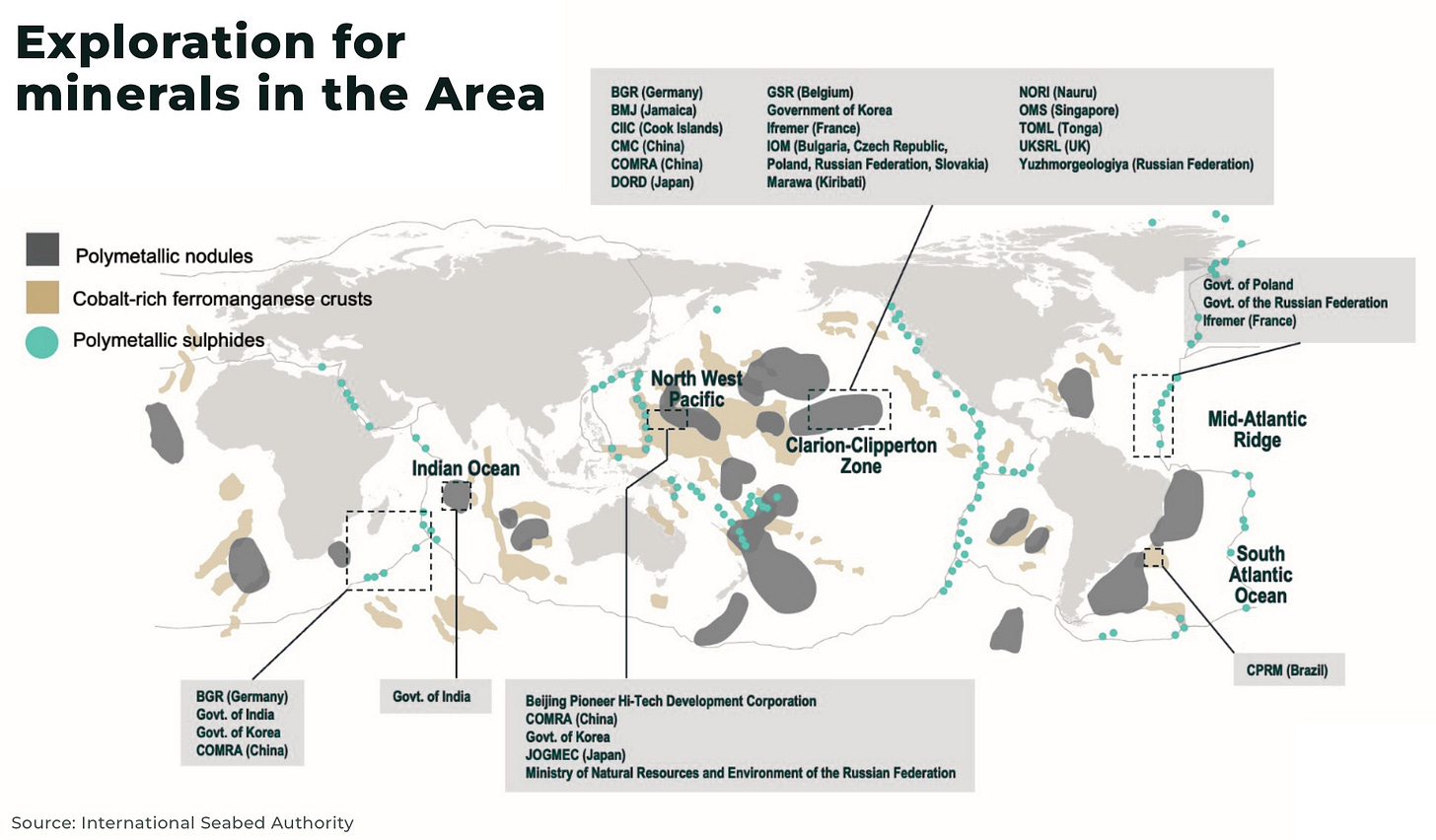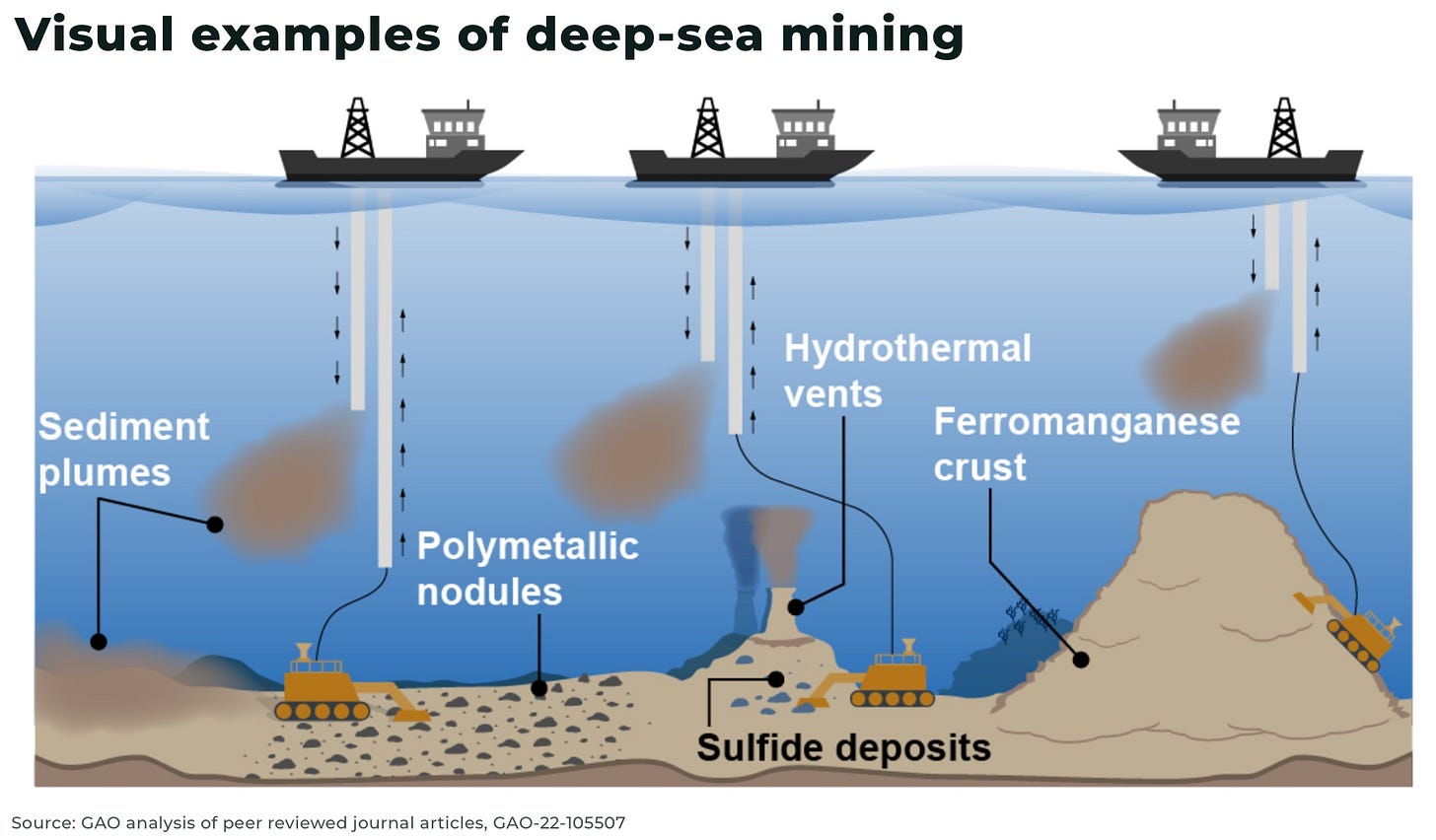Deep-sea mining is coming, whether the environmental lobby like it or not
US claims deep-sea area twice size of California containing over "50 hard minerals"
deep-sea mining has potential to meet 35-45% of global demand for critical minerals by 2065
Google, BMW, Patagonia, Samsung, Volkswagen and Volvo have called for deep-sea mining moratorium
US claims area twice seize of California containing over “50 hard minerals”, as Norway votes in favor of further exploration
🚀 Please smash the ♡ button, subscribe for the banter ✓ and share with friends and colleagues. We are always grateful for your comments and support.
In December, the US claimed one million square kilometers, an area about twice the size of California, to its land territory under the sea.
The US State Dept say it’s all about geography. The real reason is: deep-sea mining.
Deep-sea mining has the potential to meet 35-45% of global demand for critical minerals by 2065.
To put the scale of that supply in perspective: copper demand is forecast to grow to 53 million metric tons by 2050, more than all the copper consumed between 1900-2021. At 45%, deep sea mining could supply nearly 24 million metric tons.
“The US announcement on the continental shelf provides promise that the United States may one day internalize its supply chain for some strategic minerals. This would aid the efforts of Western countries to shift toward alternative sources of minerals and reduce their dependence on China"
— James Kraska, Chair and Professor of International Maritime Law, Stockton Center for International Law, US Naval War College
But there are significant challenges to actually ever mining this sunken treasure. So, will it ever happen?
What is deep-sea mining?
Lying scattered across swathes of the ocean floor, particularly in an area called the abyssal plain, are rocks known as polymetallic nodules roughly 30-100mm in diameter, that are especially rich in nickel, copper, manganese, cobalt, silver, gold and molybdenum.
One estimate suggests 21.1 billion dry tons of polymetallic nodules are in the Clarion-Clipperton Zone (CCZ) — roughly halfway between Hawaii and the Clipperton Islands — the largest in area and tonnage of the known global nodule fields.
Relative to land-based reserves, the CCZ is estimated to include:
up to x5 more cobalt
x3 more nickel
x1.2 more manganese
up to 30% of the copper and lithium
and 88% more silver
With a high ore grade in each rock, this makes the deposits in the CCZ bigger than those found in almost all current terrestrial reserves, as well as a single source for multiple minerals, with the potential for significantly less processing.
Other potential mineral deposits include polymetallic sulphides, mined from hydrothermal vents on the ocean floor, and ferromanganese crust, rich in cobalt and found on underwater mountain ranges.
Deep-sea mining is the harvesting of mineral deposits below 200m, but up to 5,000m.
To mine effectively at these depths— for example at 5,000m the pressure is approximately x500 greater than the pressure at sea level — robots are needed to collect the polymetallic modules.
Technology is evolving fast:
some robots promising to use Artificial Intelligence to power a retractable arm to pick up rocks that look like polymetallic nodules, and bring them back to the surface to a ship
other designs dredge the surface of the seafloor and use hydraulic pumps and hose systems to pump the material to surface ships and platforms
and, to extract sulfide deposits from hydrothermal vents would involve drilling into the crust
Deep-sea mining permits
The organization in charge of deep-sea mining in international waters covering 54% of the world's oceans, is the International Seabed Authority (ISA), a UN group, founded in 1994.
The ISA is working on a deep-sea mining code for commercial operations — including environmental standards, royalty payments, inspection and compliance — but failed to agree new regulations by a deadline for July 9, 2023. It is now working “with a view” to adopt new regulations by 2025.
But, because of the missed deadline, the ISA must now accept license applications from mining companies under the current regulations.
So far, the ISA has approved 31 contracts with 22 contractors, each for 15 years, for the exploration of polymetallic nodules, polymetallic sulphides, and cobalt-rich ferromanganese crusts across 1.5 million km2 (larger than Peru) 19 of these contracts are for polymetallic nodules in the Clarion Clipperton Zone (CCZ).
Deep-sea mining approval
No company, as yet, is allowed to start mining — but that could soon be about to change.
As the ISA works to finalise regulations by 2025, mining companies can now apply for a license. Although, it is unlikely any license will be granted by the ISA before 2025, the international community is split.
Costa Rica, Chile and France have urged that no permits be granted until regulations are finalized, but others such as Norway, China, Mexico and Nauru, want faster authorization.
And some countries are already planning to go ahead with deep-sea mining projects in their Exclusive Economic Zones (EEZs). For example,
Norway’s parliament has voted in favor of allowing Arctic seabed mineral exploration, despite objections from environmental campaigners, after it proposed opening its waters to deep-sea mining, in particular the Greenland Sea, the Norwegian Sea and the Barents Sea (approx 280,000km2). A Norwegian study estimates the region has 38 million tonnes of copper, almost twice the volume mined globally each year
China holds 5 of the 31 exploration licenses from the ISA, the most of any country, with exclusive rights to mine over 17% of the total area currently licensed
“China is probably the single most-active country in the ISA. One of the things that the Chinese are doing very effectively is engaging in the rule-making, and writing regulations that can favor their interests. They’re out there ahead of us, and that’s one area we need to be concerned about"
— Peter Dutton, a professor of international law at the US Naval War College
Deep-sea mining controversy
Deep-sea mining is extremely controversial, with many countries, companies and NGOs opposed for environmental reasons, calling for more scientific assessment into the potential impact of deep-sea mining on the unique and largely little-understood ecosystems on the ocean floor, as well as risks to the ocean as a global carbon sink.
For example:
Google, BMW, Patagonia, Samsung, Volkswagen and Volvo have called for a moratorium, announcing they will not buy minerals from deep-sea mining or finance any such projects
the UK has recently made a significant u-turn to oppose deep-sea mining "until sufficient scientific evidence is available to assess the potential impact of deep sea mining activities"
the EU Commission and Parliament are calling for a moratorium
in the USA, the American Seabed Protection Act bill has been introduced to put a moratorium on deep-sea mining activities in American waters or by American companies on the high seas
Metals for the Energy Transition
Global net-zero targets, especially in the West, are fast approaching and demand for critical minerals is expected to increase three-and-a-half times by 2030.
The challenge is supply, which, as we have outlined on The Oregon Group, is struggling to keep up.
Deep-sea mining companies argue the critical minerals on the ocean floor offer the energy transition an enormous supply with less environmental impact than terrestrial mining, for example, deforestation, tailings and carbon emissions.
Conclusion
It is undisputed that there lies enormous critical mineral wealth on the surface of the ocean — and the technology now exists to excavate it. The challenge is whether it is environmentally acceptable to do so.
However, ultimately, we do not think this will stop countries and companies going ahead regardless.
We believe deep-sea mining will be approved in EEZs first, such as Norway, where governments have direct control.
But the true riches lie in regions such as the CCZ.
The ISA has given a 2025 deadline — and at least one company plans to submit its application next summer, with a one-year review, and then production by Q4 2025 — but, it is also possible the deadline for approval of deep-sea mining regulations and licenses could be further delayed by unresolved deadlock.
Further deadlock over license approval would be highly problematic for Western companies but, similar to the problems in deep-water fishing, the CCZ is a region so vast that it's almost impossible for any navy to regulate — paving the way for what we suspect is the inevitability of illegal deep-sea mining by some non-Western countries.
And, once the metals have been excavated and processed, whether legally or illegally, the minerals will be difficult to trace and there will very quickly be demand, despite some companies promising not buy them.
And, in the West, momentum behind the recent US claims — under, we think it’s important to note, a Democratic president — are best summarized by this quote:
“Politicians of all stripes have told me, however, that making a claim for extended continental shelf is in the US national interest, so when there is a will, there may be a way… a US claim is solid until anyone with rights and standing will challenge it”
— Mead Treadwell, Co-Chair, Advisory Committee, Polar Institute
The new Extended Continental Shelf claim by the US shows both a will and way. Others will be sure to follow.
Exposure
Investing in deep-sea mining carries significant risk and opportunity.
for the least risk, investors should focus on countries and companies that are working to open up their EEZs, such as Norway.
the biggest risk — and opportunities — lie in ISA approval of mining licenses in the regions such as the CCZ. As we've highlighted, there are, so far, 22 contractors from the US, UK, Poland, Japan, Korea, India, China and more
Due diligence is essential on any company, to ensure it has both the financing and team capable of following through.
It may sound easy, just collecting rocks from the ocean floor, but the deep-sea remains some of the deepest, most remote regions on earth. There will be very dangerous storms — metaphorically and literally — ahead.
🚀 Please smash the ♡ button, subscribe for the banter ✓ and share with friends and colleagues. We are always grateful for your comments and support.











I appreciate the information here, but it's difficult to "like" the it. Claiming "geographically" is one thing; drilling (or however people think they're going to access these minerals w/o disturbing ecosystems) is another thing entirely. Thanks for the info, though.
Although already decades in development the prospect of effective 'at scale' commercial deep Sea mining engineering machines is still some way off?